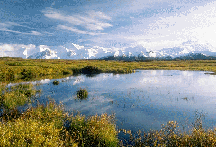Please read the pages indicated by Z-22 and study Behavioral Objective #22. In the far northern parts of North America and Europe and Asia is a region known as the tundra. The tundra is the most continuous of the earth's biomes. It forms a circumpolar band that is around the poles, interrupted only narrowly by the North Atlantic and the Barren Sea. It corresponds to the region where the subsoil is permanently frozen. The land has the appearance of gently rolling plains with many lakes, ponds, and bogs in the depressions between the rolling plains. Tundra actually is a Siberian word which means north of the timberline.
 There
are, in fact, very few trees on the tundra, and when they are present they
are small and widely scattered. They are definitely not the dominant
vegetation except on the very local scale. Most of the ground is covered
by mosses, lichens, and few species of grasses. The lichens are often
called reindeer moss because of the typical growth pattern. There are
quite a few perennial herbs which are able to withstand frequent freezing
and which grow rapidly during the brief, cold summers. These plants often
carpet the tundra with brightly colored flowers. Animals of the tundra
withstand the cold by living in burrows or having large body size or good
insulation to retain heat. Many animals species are migratory.
Reindeer, carabou, arctic wolves, arctic foxes, arctic hares, and lemings
are among the principle mammals. Polar bears are common on parts of the
tundra near the coast. Usually vast numbers of birds, particularly shore
birds and water fowl, nest on the tundra during the summer, but they are
not permanent residents. These migrate south for the winter. Insects,
particularly flys and mosquitoes, are incredibly abundant. In short, far
from being a barren-like land as many people think, the tundra actually
teams with life. It is true, however, that though the number of individual
organisms on the tundra is often very large, the number of species is
quite limited. Study the map showing the biomes of the world to locate
where this biome may be found on earth.
There
are, in fact, very few trees on the tundra, and when they are present they
are small and widely scattered. They are definitely not the dominant
vegetation except on the very local scale. Most of the ground is covered
by mosses, lichens, and few species of grasses. The lichens are often
called reindeer moss because of the typical growth pattern. There are
quite a few perennial herbs which are able to withstand frequent freezing
and which grow rapidly during the brief, cold summers. These plants often
carpet the tundra with brightly colored flowers. Animals of the tundra
withstand the cold by living in burrows or having large body size or good
insulation to retain heat. Many animals species are migratory.
Reindeer, carabou, arctic wolves, arctic foxes, arctic hares, and lemings
are among the principle mammals. Polar bears are common on parts of the
tundra near the coast. Usually vast numbers of birds, particularly shore
birds and water fowl, nest on the tundra during the summer, but they are
not permanent residents. These migrate south for the winter. Insects,
particularly flys and mosquitoes, are incredibly abundant. In short, far
from being a barren-like land as many people think, the tundra actually
teams with life. It is true, however, that though the number of individual
organisms on the tundra is often very large, the number of species is
quite limited. Study the map showing the biomes of the world to locate
where this biome may be found on earth.
Activity: Write out a paragraph explaining the environmental conditions that has caused the formation of the tundra region and identify producers, consumers (primary and secondary) and decomposers located in this area. Include the following terms: permafrost, season length, rainfall, temperatures, grasses, sedges, type of birds and mammals, insects.
Which of the following is NOT true concerning the tundra?
- a. Most plant species are small such as sedges, grasses, lichen.
- b. The ground has a layer of permanently frozen soil (permafrost).
- c. This area has short growing seasons.
- d. Many of the animal species consist of amphibians(frogs) and reptiles(snakes).
Created by the Multimedia Development Lab, Academic Technology Services.
Last modified November 19, 1997.